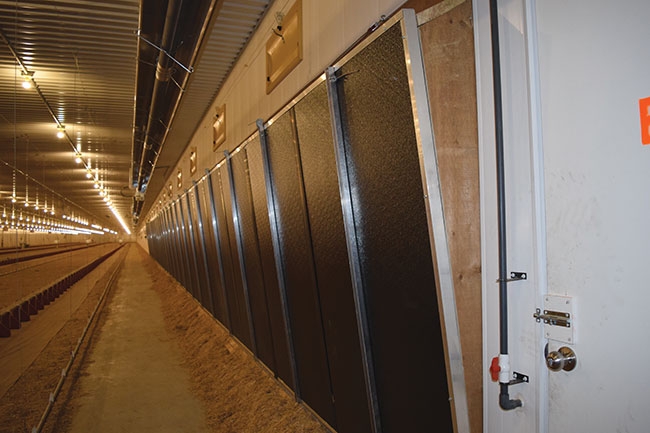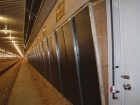
Guts of Growth: Heat stress in poultry
By Dr. Kayla Price
Features Bird Management Production Heat StressHow to prepare your birds for summer temperatures.
 Increasing ventilation during high heat periods and using cooling systems like the one pictured here are some of the critical first steps to help manage heat levels in the barn. PHOTO CREDIT: Clark Ag Systems
Increasing ventilation during high heat periods and using cooling systems like the one pictured here are some of the critical first steps to help manage heat levels in the barn. PHOTO CREDIT: Clark Ag SystemsHot summer temperatures have arrived. That means it’s important to be prepared for the heat and the impact this could have on your birds.
What is heat stress?
Birds have a thermoneutral zone where a range of ambient temperatures allows them to regulate a normal internal body temperature through just heat loss and heat production. For example, the body temperature for chickens is 41.5°C (106.7 °F), turkeys is 41.2°C (106.°F) and ducks is 42.1°C (107.8°F).
Birds naturally produce their own body heat through metabolism as the byproduct of different internal biological processes. The amount of body heat they produce can be affected by many factors including body weight, production, activity and feed intake.
The perceived temperature the bird feels is impacted by relative humidity and environmental temperature, and when these factors rise, they can experience heat stress.
High humidity can make lower temperatures seem warmer than they are, and as a result heat stress may also happen at slightly lower temperatures if there is a higher relative humidity.
Not only can intensity and duration of exposure to heat stress play a role in how birds react, but so can other compounding factors.
Aggravating elements could include age, cyclic variation in temperature, body type and size and genotype.
How do birds manage excess heat loss?
Unlike humans, birds do not have sweat glands, so they release heat through convection, conduction, radiation, evaporative cooling and vasodilation. Birds lose heat through convection where heat rises off the body of the bird to the cooler surrounding air. In a heat stress situation, the birds may increase this type of heat loss through increasing their surface area via spreading their wings.
When birds lose heat through conduction, they transfer heat from one surface in direct contact with another surface. Essentially, the bird can sit on a floor or by a wall that may be slightly cooler than their body temperature to help release the heat. In a heat stress situation, birds may seek the perimeter of their environment. With birds reared on litter, this may mean that the birds seek out the walls or dig into the litter. With radiation as a heat loss method, heat can be transferred to a distant surface or object.
Vasodilation is a method of heat loss where the blood vessels that are close to the outside of the body, such as in the comb and wattles of the bird, become wider and allow more blood to flow. This increase in blood flow near the outside of the body brings the internal body heat to the surface to be lost.
Evaporative cooling is another method of heat loss where the bird completes rapid, shallow breaths with their mouth open to release water from the mouth and respiratory tract to help remove heat from this surface. Panting requires muscle activity and energy use which can generate body heat, but slow panting allows for a balance between the heat produced and the heat lost.
On the other hand, fast panting (up to 10 times the resting rate), which may happen in high heat stress conditions, does not allow for this balance and is not sustainable. This fast panting requires increased muscle activity and energy use which can tire the birds (decrease production), alter gas, pH and electrolyte balance, and increase body heat due to the increased muscle activity. In high heat stress conditions, body heat production may decrease as feed consumption, activity and production decrease
Impact of heat stress on the bird
Heat stress can have negative impacts on many of different aspects of the bird’s function, but this article will only discuss the impact on the immune system and gut. Under thermoneutral conditions, stress molecules within the bird are balanced and different molecules help to regulate body temperature and metabolic activity. In heat stress conditions, some stress molecules may be increased, leading to an imbalance.
In humans, the imbalance and increase in stress molecules have been shown to have an impact on behaviour, heart rate, blood pressure and appetite. These stress molecules have also been shown to decrease immune function. This suppression of the immune system during heat stress has also been found in broiler and layer research. The immune system acts as the body’s defense system so if this protection is reduced, the bird may be more vulnerable to other stressors and changes.
Another area can be impacted during heat stress is the intestinal tract. Under heat stress conditions, the blood flow is decreased to the intestinal tract, which in turn decreases oxygen delivery to the tissue. This decrease in oxygen levels may lead to oxidative stress which can be damaging to tissues and organs. Oxidative damage can also impact tight junctions which connect adjunct intestinal cells and provide a protective barrier.
If the tight junctions are damaged or negatively impacted the intestinal tract cannot act as a good barrier. This damage can also lead to other issues such as increased inflammation, decreased ability of the intestine to absorb nutrients and may change the intestinal environment which could impact the intestinal microbe balance. In high heat stress conditions, the birds may reduce their feed intake which could have a further impact on the intestinal tract.
Managing heat stress
Elements to take into consideration to manage heat stress, include barn environment, feed and water management, as well as different additives that can be used in the water and feed. In the barn, increasing ventilation during high heat periods and using cooling systems are some of the critical first steps to help manage heat levels.
Generally, birds drink around 1.6 to two times as much the equivalent weight of feed, but with increased panting and water loss through skin during heat stress the birds need to replenish this water by drinking more than non-stressed birds. It is important to make sure birds have access to cool (below 25°C ), clean water during times when temperatures and humidity are high.
Adding electrolytes, flavours and organic acids can help encourage water consumption during these times. Other additives, like mannan oligosaccharides or bioavailable minerals, can help support the intestine’s natural defenses in heat-stressed birds, especially when feed intake has decreased. These additives may be used at strategic times such as during brooding and just before and during a heat stress time. Similar additives may also be used in the feed over time as another proactive approach.
In addition, activity of the birds should be limited during the hottest times of the day. Birds placed in cool spring temperatures and raised through the heat of summer may experience more issues with heat stress as so it’s important to be prepared for that first heat wave. To help beat the heat and reduce the stress on the birds, assess the barn environment, water quality, feed management as well as additives for water and feed to help keep the birds comfortable during the heat.
Print this page

